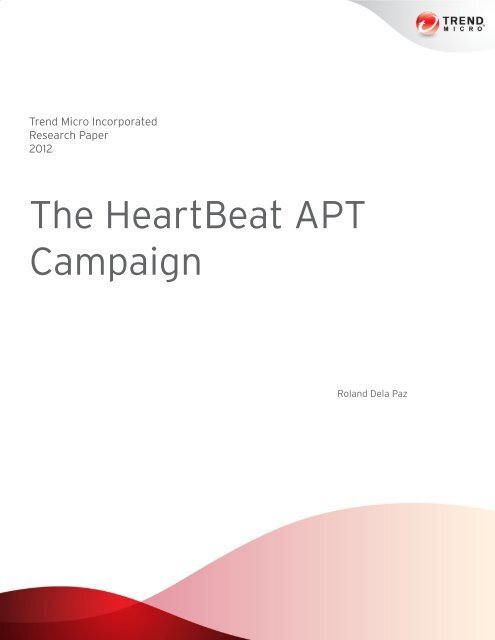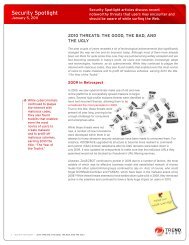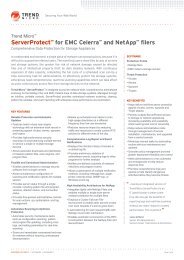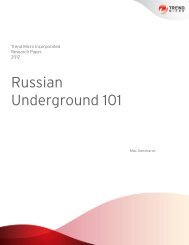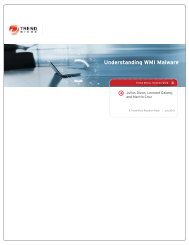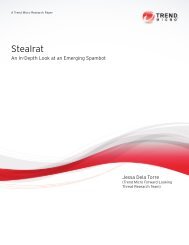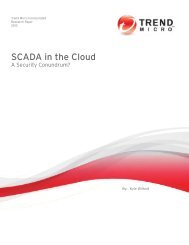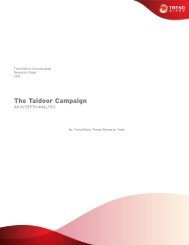Read The HeartBeat APT Campaign - Trend Micro
Read The HeartBeat APT Campaign - Trend Micro
Read The HeartBeat APT Campaign - Trend Micro
Create successful ePaper yourself
Turn your PDF publications into a flip-book with our unique Google optimized e-Paper software.
<strong>Trend</strong> <strong>Micro</strong> Incorporated<br />
Research Paper<br />
2012<br />
<strong>The</strong> <strong>HeartBeat</strong> <strong>APT</strong><br />
<strong>Campaign</strong><br />
Roland Dela Paz
Contents<br />
About This Paper................................................................................................................................... 1<br />
Introduction............................................................................................................................................ 1<br />
<strong>Campaign</strong> Targets................................................................................................................................ 2<br />
Context.................................................................................................................................................... 2<br />
Attack Vector........................................................................................................................................ 3<br />
Infection Flow........................................................................................................................................4<br />
<strong>The</strong> RAT Component............................................................................................................................5<br />
Backdoor Functionalities.............................................................................................................5<br />
Installation and Persistence.......................................................................................................5<br />
C&C Communication....................................................................................................................6<br />
Command and Control........................................................................................................................8<br />
<strong>HeartBeat</strong> <strong>Campaign</strong> Codes and Decoy Documents....................................................................8<br />
Relationships among C&C Domains, IPs, and <strong>Campaign</strong>s...........................................................9<br />
Attribution.............................................................................................................................................10<br />
Conclusion.............................................................................................................................................10<br />
Timeline.................................................................................................................................................10<br />
Defending against the <strong>HeartBeat</strong> <strong>Campaign</strong>.................................................................................11<br />
<strong>Trend</strong> <strong>Micro</strong> Threat Protection Against <strong>The</strong> <strong>HeartBeat</strong> <strong>Campaign</strong> Components.................12<br />
PAGE ii | THE HEARTBEAT <strong>APT</strong> CAMPAIGN
About This Paper<br />
Introduction<br />
This paper exposes a targeted attack called “<strong>HeartBeat</strong>,”<br />
which has been persistently pursuing the South Korean<br />
government and related organizations since 2009. This<br />
paper will discuss how their specifically crafted campaigns<br />
infiltrate their targets.<br />
Compared to most advanced persistent threat (<strong>APT</strong>)<br />
campaigns with diverse targeted industries, the <strong>HeartBeat</strong><br />
campaign is an isolated case. Furthermore, we will examine<br />
their attack methodologies which include their attack<br />
vector, the remote administration tool (RAT) component,<br />
and command-and-control servers. Finally, we will discuss<br />
how this information can be useful in developing defensive<br />
strategies in protecting organizations as well as predicting<br />
future targets.<br />
Today’s cybercriminals try to infect as many users as<br />
possible. <strong>The</strong>ir goal is simple—to monetize the resources or<br />
data from infected machines in any way they can. Behind<br />
such attacks are highly covert targeted campaigns known<br />
as <strong>APT</strong>s.<br />
While targeted campaigns continue to increase, research<br />
efforts by the security industry reveal that some of these<br />
attacks have existed for several years. 1 Depending on the<br />
motive, <strong>APT</strong> campaigns may attack various industries,<br />
organizations or communities from different regions and<br />
countries. For instance, the Luckycat campaign targeted<br />
the aerospace, energy, engineering, shipping, and military<br />
research industries in India and Japan. 2 Additionally,<br />
they targeted the Tibetan activists’ community. <strong>The</strong><br />
IXESHE campaign, on the other hand, targeted East Asian<br />
governments, Taiwanese electronics manufacturers,<br />
and a telecommunications company. 3 While most of<br />
these campaigns have multiple targets, smaller, more<br />
subtle campaigns with exceedingly specific targets are<br />
also present. <strong>The</strong> Taidoor campaign is an example of<br />
this, where all of the compromise victims were from<br />
Taiwan, and the majority of which were government<br />
organizations. 4<br />
This research paper will delve into a targeted campaign<br />
that targets organizations and communities within South<br />
Korea. We call this malicious operation the “<strong>HeartBeat</strong><br />
campaign.”<br />
1 http://www.trendmicro.com/cloud-content/us/pdfs/securityintelligence/white-papers/wp_dissecting-lurid-apt.pdf<br />
2 http://www.trendmicro.com/cloud-content/us/pdfs/securityintelligence/white-papers/wp_luckycat_redux.pdf<br />
3 http://www.trendmicro.com/cloud-content/us/pdfs/securityintelligence/white-papers/wp_ixeshe.pdf<br />
4 http://www.trendmicro.com/cloud-content/us/pdfs/securityintelligence/white-papers/wp_the_taidoor_campaign.pdf<br />
PAGE 1 | THE HEARTBEAT <strong>APT</strong> CAMPAIGN
<strong>Campaign</strong> Targets<br />
Context<br />
<strong>The</strong> <strong>HeartBeat</strong> campaign appears to target government<br />
organizations and institutions or communities that are<br />
in some way related to the South Korean government.<br />
Specifically, we were able to identify the following targets:<br />
• Political parties<br />
• Media outfits<br />
• A national policy research institute<br />
• A military branch of South Korean armed forces<br />
• A small business sector organization<br />
<strong>The</strong> first <strong>HeartBeat</strong> campaign remote access tool (RAT) 5<br />
component was discovered in June 2012 in a Korean<br />
newspaper company network. Further investigation<br />
revealed that the campaign has been actively distributing<br />
their RAT component to their targets in 2011 and the first<br />
half of 2012. Furthermore, we uncovered one malware<br />
component that dates back to November 2009. This<br />
indicates that the campaign started during that time or<br />
earlier.<br />
Earlier versions of the <strong>HeartBeat</strong> campaign’s RAT<br />
component contained the following strings in their codes:<br />
Thus, the campaign name “<strong>HeartBeat</strong>.”<br />
• Branches of South Korean government<br />
<strong>The</strong> profile of their targets suggests that the motive<br />
behind the campaign may be politically motivated.<br />
Figure 1. Code used in the <strong>HeartBeat</strong> campaign’s RAT component<br />
PAGE 2 | THE HEARTBEAT <strong>APT</strong> CAMPAIGN<br />
5 http://en.wikipedia.org/wiki/Remote_administration_software
Attack Vector<br />
In order to gain control over targets systems, <strong>HeartBeat</strong><br />
perpetrators install a RAT in prospective victims’ systems.<br />
This RAT arrives as a disguised or fake document which<br />
is actually a bundled file. <strong>The</strong> bundled file contains both<br />
a decoy document and the RAT installer that has been<br />
packaged together using a binder tool. Once it runs, the<br />
decoy document is displayed to the user while the RAT<br />
unknowingly executes in the background.<br />
Based on the samples we collected, the campaign’s decoy<br />
documents used the file formats .JPG, .PDF, XLS, and HWP,<br />
the Korean government standard word processor format.<br />
One of the previous <strong>HeartBeat</strong> attacks even dropped a<br />
pornographic .JPG image as decoy. Below is a screenshot<br />
of a Hangul Word Processor (.HWP) document used as bait<br />
in November 2011. Its document title roughly translates to<br />
“Information to the President.hwp.”<br />
It is unclear how these packaged files specifically arrive on<br />
victims’ systems, but we highly suspect that spearphishing<br />
emails 6 containing these packaged malware were primarily<br />
used to distribute them. In fact, the packaged malware<br />
used the icon of the decoy document in order to look<br />
legitimate. For instance, if the decoy is an XLS file, the<br />
package will appear to have an XLS document icon. In<br />
addition, some of the decoy files required passwords in<br />
order to be viewed.<br />
Figure 3. A decoy .HWP document<br />
Figure 2. Example of a decoy Adobe <strong>Read</strong>er document<br />
<strong>The</strong> previously mentioned techniques are commonly used<br />
in spearphishing attacks where prospective victims are<br />
lured to open a seemingly benign document attachment.<br />
In order to appear more legitimate, some of these emails<br />
contain password protected documents. A password is<br />
then provided in the email body as a social engineering<br />
technique.<br />
6 http://blog.trendmicro.com/taiwan-spear-phishers-target-gmail-users/<br />
PAGE 3 | THE HEARTBEAT <strong>APT</strong> CAMPAIGN
Infection Flow<br />
Once users open the packaged malicious file, the actual document is displayed to the user while a RAT installer in<br />
.EXE format runs in the background. <strong>The</strong> RAT installer, on the other hand, drops a .DLL file that is then injected to the<br />
legitimate process svchost.exe. <strong>The</strong> injected code in svchost.exe then connects to the malware command and control<br />
(C&C) server to register infection and wait for remote commands.<br />
Figure 4. Infection diagram for the <strong>HeartBeat</strong> campaign<br />
TREND MICRO INCORPORATED<br />
<strong>Trend</strong> <strong>Micro</strong> Incorporated (TYO: 4704; TSE: 4704), a global cloud security<br />
leader, creates a world safe for exchanging digital information with its Internet<br />
content security and threat management solutions for businesses<br />
and consumers. A pioneer in server security with over<br />
20 years’ experience, we deliver top-ranked client, server and cloudbased<br />
security that fits our customers’ and partners’ needs, stops<br />
new threats faster, and protects data in physical, virtualized and cloud<br />
environments. Powered by the industry-leading <strong>Trend</strong> <strong>Micro</strong> Smart Protection<br />
Network cloud computing security infrastructure, our products<br />
and services stop threats where they emerge—from the Internet. <strong>The</strong>y are<br />
supported by 1,000+ threat intelligence experts around the globe.<br />
TREND MICRO INC.<br />
10101 N. De Anza Blvd.<br />
Cupertino, CA 95014<br />
U.S. toll free: 1 +800.228.5651<br />
Phone: 1 +408.257.1500<br />
Fax: 1 +408.257.2003<br />
www.trendmicro.com<br />
©2012 by <strong>Trend</strong> <strong>Micro</strong>, Incorporated. All rights reserved. <strong>Trend</strong> <strong>Micro</strong> and the <strong>Trend</strong> <strong>Micro</strong> t-ball logo are trademarks or registered trademarks of <strong>Trend</strong> <strong>Micro</strong>, Incorporated. All other product or company<br />
names may be trademarks or registered trademarks of their owners.<br />
PAGE 4 | THE HEARTBEAT <strong>APT</strong> CAMPAIGN
<strong>The</strong> RAT Component<br />
Backdoor Functionalities<br />
<strong>The</strong> <strong>HeartBeat</strong> campaign’s RAT component allows<br />
attackers to remotely execute the following commands on<br />
affected hosts:<br />
• List running processes and their respective process<br />
IDs<br />
• Download and execute file(s)<br />
• Update itself<br />
• Uninstall itself<br />
• Create or terminate a process<br />
• List available removable and fixed drives<br />
• List existing files and their creation date/time<br />
<strong>The</strong> RAT installer in turn drops a .DLL component which<br />
contains the backdoor capabilities. In order to stay hidden,<br />
the .DLL uses file names similar to legitimate applications.<br />
Below is a list of file names used:<br />
• %Program Files%\Common Files\Services\6to4nt.dll<br />
• %Program Files%\Common Files\System\6to4nt.dll<br />
• %Program Files%\Windows NT\Accessories\6to4nt.dll<br />
• %Program Files%\Windows NT\htrn.dll<br />
• %Program Files%\Windows NT\htrn_jls.dll<br />
• %Program Files%\Windows NT\hyper.dll<br />
• %System%\Network Remote.dll<br />
• %System%\SvcHost.dll<br />
Some these dropped .DLL files use fake file properties<br />
in order to not appear suspicious. <strong>The</strong> following is an<br />
example:<br />
• Upload file(s)<br />
• Delete file(s)<br />
• Get the file creation date/time of a specific file<br />
• Open a remote command shell access<br />
• Reboot the system<br />
<strong>The</strong>se commands give the attackers complete control over<br />
their victims’ systems. Attackers also have the option to<br />
uninstall the RAT any time to cover their tracks and avoid<br />
being discovered.<br />
Installation and Persistence<br />
<strong>The</strong> RAT installer is initially dropped and executed by the<br />
packaged file using any of the following file names:<br />
• %System%\msrt.exe<br />
• %Program Files%\Common Files\AcroRd32.exe<br />
• %Program Files%\Common Files\config.exe<br />
• %Program Files%\Common Files\explorer.exe<br />
Figure 5. A.DLL that uses fake file properties<br />
PAGE 5 | THE HEARTBEAT <strong>APT</strong> CAMPAIGN
In some cases, the RAT installer drops 2 .DLL files where<br />
one of the .DLLs serves as a loader of the other .DLL file<br />
which contains the backdoor payload.<br />
<strong>The</strong> .DLL component is then registered as a service<br />
through the following added registries:<br />
HKEY_LOCAL_MACHINE\SYSTEM\CurrentControlSet\<br />
Services\{service name}<br />
Type = “20”<br />
Start = “2”<br />
ErrorControl = “1”<br />
ImagePath = “%SystemRoot%\System32\svchost.exe<br />
-k netsvcs”<br />
ObjectName = “LocalSystem”<br />
HKEY_LOCAL_MACHINE\SYSTEM\CurrentControlSet\<br />
Services\{service name}\Parameters<br />
ServiceDll = C:\Program Files\Windows NT\htrn.<br />
dll<br />
HKEY_LOCAL_MACHINE\SYSTEM\CurrentControlSet\<br />
Services\{service name}\Security<br />
Security = {values}<br />
HKEY_LOCAL_MACHINE\SYSTEM\CurrentControlSet\<br />
Services\{service name}\Enum<br />
0 = “Root\LEGACY_{service name}\0000”<br />
Count = “1”<br />
NextInstance = “1”<br />
*{service name} may be “6to4”, “Ias” or<br />
“Irmon”.<br />
C&C Communication<br />
Once the RAT’s .DLL component has been injected to<br />
svchost.exe, the malware attempts to register itself to the<br />
C&C server by sending the following information from the<br />
affected system:<br />
• Computer name<br />
• Local IP address<br />
• Service pack<br />
<strong>The</strong>se data are sent along with a campaign code and the<br />
string “qawsed”. While the “qawsed” string is not present<br />
in earlier versions of their RAT, we suspect that the<br />
attackers only recently added this as a default campaign<br />
password.<br />
<strong>The</strong> RAT’s C&C communication is encrypted with XOR<br />
encryption using a single byte key, 02H. Furthermore, the<br />
data being transferred and received by the RAT C&C are<br />
800H (2,048 bytes) in size.<br />
<strong>The</strong> service is then invoked once installed. This results<br />
in the .DLL being injected to svchost.exe process. This<br />
registry modification allows the RAT to execute upon every<br />
system startup.<br />
After installation the RAT installer deletes itself, which<br />
leaves only the disguised .DLL and related registry entries<br />
on the affected system.<br />
Note that the presence of any of the files or registries<br />
above may be an indication of a possible <strong>HeartBeat</strong><br />
infection in a system.<br />
Figure 6. RAT’s encryption algorithm before sending data to its<br />
C&C server<br />
PAGE 6 | THE HEARTBEAT <strong>APT</strong> CAMPAIGN
Figure 7. RAT’s decryption code upon receiving data from the C&C server<br />
During the RAT’s phone home, the following TCP traffic is observed on the network:<br />
When decrypted, the above traffic looks as follows:<br />
<strong>The</strong> majority of the RAT variants used port 80. Recent<br />
variants, however, were observed to use port 443. Other<br />
ports we have seen being utilized are port 5600 and port<br />
8080.<br />
Earlier RAT variants did not use encryption on their C&C<br />
communication. Moreover, they only sent the computer<br />
name and campaign code during phone home. Below is a<br />
screenshot of the unencrypted C&C communication.<br />
PAGE 7 | THE HEARTBEAT <strong>APT</strong> CAMPAIGN
<strong>The</strong> C&C traffic size also varied in previous versions. Some<br />
early variants used traffic that are 28H (40 bytes) and<br />
1004H (4,100 bytes) in size.<br />
Additionally, the port, C&C address, campaign code and<br />
password are hardcoded in the RAT’s malware body<br />
in plain text. In some RAT versions, however, they are<br />
encrypted and are decrypted only during run-time,<br />
possibly to protect the RAT from static analysis by security<br />
researchers.<br />
<strong>The</strong>se variations in their RAT component indicate that it<br />
has since been undergoing development.<br />
Command and Control<br />
<strong>The</strong> <strong>HeartBeat</strong> campaign’s C&C domains appear to utilize<br />
a site redirection service. <strong>The</strong>ir C&C sites redirect to IP<br />
addresses from ISPs in Armenia, USA, Japan, India and<br />
Korea. We observed that they updated the IP address<br />
of some of their C&C domains. Likewise, all of their IP<br />
addresses belong to legitimate ISPs. Considering this,<br />
we suspect that these IP addresses are compromised<br />
hosts that act as proxy servers which redirects traffic to<br />
the actual C&C servers. Again, this adds another layer of<br />
anonymity to the <strong>HeartBeat</strong> perpetrators.<br />
Domain<br />
ahnlab.myfw.us<br />
kissyou01.myfw.us<br />
kita.myfw.us<br />
login.sbs.com.PassAs.us<br />
mail2.myfw.us<br />
park007.myfw.us<br />
snrp.UglyAs.com<br />
www.banking.com.PassAs.us<br />
www.huyang.go.kr.PassAs.us<br />
www.kinu.or.kr.rr.nu<br />
www.kndu.ac.kr.myfw.us<br />
young03.myfw.us<br />
IP Address<br />
XXX.XXX.217.123 /XXX.XX.121.84<br />
XX.XXX.203.122 / XX.XXX.20.103<br />
XXX.XXX.217.123 / XXX.XX.121.84<br />
XXX.XXX.178.50<br />
XX.XXX.15.63 / XXX.XXX.198.93<br />
unknown<br />
XXX.XXX.169.45<br />
XXX.XXX.178.50<br />
XXX.XXX.217.123 / XX.XXX.136.115<br />
XXX.XXX.178.50<br />
XXX.XXX.4.180<br />
XX.XXX.203.122<br />
Table 1. List of <strong>HeartBeat</strong> C&Cs<br />
<strong>HeartBeat</strong> <strong>Campaign</strong> Codes and Decoy<br />
Documents<br />
<strong>The</strong> campaign codes and decoy documents used by the<br />
<strong>HeartBeat</strong> attackers provided valuable insights on their<br />
campaigns. In fact, majority of their campaign codes<br />
included number combinations which represented the<br />
month and date in MMDD format when the attack attempt<br />
was executed. <strong>The</strong> rest of the campaign code string<br />
often describes the decoy document that was used in a<br />
specific campaign. For instance, a campaign code from<br />
October 2011 is “army-1022” where attackers used a decoy<br />
document containing military-related information.<br />
1119HWP<br />
kris0315<br />
PDF-0417<br />
gh-0525<br />
0909-jpg<br />
<strong>Campaign</strong> code<br />
None<br />
None<br />
None<br />
None<br />
qawsed<br />
0916 qawsed<br />
jpg-jf-0925<br />
army-1022<br />
1103-ghui<br />
1113-minzhu<br />
ajh7884@han<br />
qawsed<br />
qawsed<br />
qawsed<br />
qawsed<br />
qawsed<br />
001 qawsed<br />
0305-ziyoudang<br />
0326-xuehui<br />
0328-junf<br />
0329-mnd<br />
1q2w3e4r<br />
0520-tiegang<br />
guohui-0604<br />
qawsed<br />
qawsed<br />
qawsed<br />
qawsed<br />
None<br />
qawsed<br />
qawsed<br />
Table 2. <strong>Campaign</strong> codes used<br />
Password<br />
On the other hand, decoy documents’ contents were<br />
also very specific to their targets. For example, some of<br />
these documents included logos of specific groups. This<br />
information helped us identify their targeted organizations<br />
and communities in their previous campaigns.<br />
PAGE 8 | THE HEARTBEAT <strong>APT</strong> CAMPAIGN
Relationships among C&C Domains, IPs, and <strong>Campaign</strong>s<br />
Figure 7. Relationships between <strong>HeartBeat</strong> attack components<br />
PAGE 9 | THE HEARTBEAT <strong>APT</strong> CAMPAIGN
Attribution<br />
Clues relating to the attackers remain very limited. Using<br />
compromised hosts as C&C proxy servers minimizes the<br />
possibility of tracking potential threat actors. While a<br />
number of their campaign codes included Chinese words<br />
such as guohui, xuehui and minzhu, they appear to be<br />
comfortable using the English language. Some of the C&C<br />
domain names even contained English words. In addition,<br />
the binder tool and the RAT component are written<br />
in English. For instance, some text from the packaged<br />
components’ body included “Select Files!” and “Bind<br />
Success!”, while the RAT component included strings<br />
such as “Uninstall…ok” and the name of the RAT itself,<br />
“<strong>HeartBeat</strong>.”<br />
Threat actors and entities that use collected information<br />
from targets may be two separate parties that are only<br />
related in a professional and malicious manner. In this<br />
case, determining the latter may be impossible. Likewise,<br />
it is very difficult to identify the threat actors behind<br />
the <strong>HeartBeat</strong> campaign given the limited amount of<br />
information available.<br />
Conclusion<br />
<strong>The</strong> Heartbeat campaign has been successfully executing<br />
targeted attacks since 2009. In order for attackers to<br />
properly track their campaigns and victims, they used<br />
campaign codes that contained the campaign dates and<br />
strings that described specific campaigns. <strong>The</strong>se campaign<br />
codes are embedded in their RAT binaries and were sent<br />
to their C&C servers along with information regarding the<br />
targets’ system. Additionally, they used a commercial site<br />
redirection service for their C&C domains. <strong>The</strong>se domains<br />
redirected to various IP addresses that belonged to<br />
legitimate ISPs, which may be compromised hosts that act<br />
as proxy servers. This effectively hides the real location of<br />
the attackers behind <strong>HeartBeat</strong>. While having an isolated<br />
target may have helped them stay under the security<br />
industry’s radar, the attackers illustrated that they were<br />
very careful but persistent.<br />
Understanding targeted campaigns and their<br />
methodologies is fundamental in protecting both end<br />
users and organizations. Not only does it help in coming<br />
up with effective defensive strategies through multiple<br />
protection layers, it also helps with predicting possible<br />
targets in the future and ultimately, raise awareness. As<br />
of this writing, the <strong>HeartBeat</strong> <strong>APT</strong> campaign remains an<br />
active targeted campaign.<br />
Timeline<br />
We collected 19 set of samples related to <strong>HeartBeat</strong><br />
campaign from November 2009 to June 2012. This<br />
translates to 19 campaigns where the vast majority<br />
of which were distributed between 2011 and 2012.<br />
Nonetheless, the limited number of samples we were<br />
able to obtain still means that the campaign is indeed<br />
persistent. <strong>The</strong> isolated nature of this targeted attack<br />
and its small user base may only require the <strong>HeartBeat</strong><br />
perpetrators to carry out minimal campaigns in order to<br />
infiltrate their targets.<br />
<strong>Campaign</strong><br />
Date<br />
(MM/DD/YY)<br />
MD5 (.DLL component)<br />
Compile<br />
Date<br />
(MM/DD/YY)<br />
11/19/09 7c6b44d8d87898e7e5deeeb1961b5ae6 9/17/2009<br />
03/15/11 fcf42cadb3a932989c8e2b29cef68861 12/24/2010<br />
04/17/11 aab129ffd3bf5ceeae2e0f332217bebc 3/18/2011<br />
05/25/11 86547d674e7c7da55e8cae359819832f 5/6/2011<br />
09/09/111 f947e63b14853a69b8ed2648869b5e10 7/25/2011<br />
09/16/11 7f1a633384ec97fae9d95d1df9e1135a 7/25/2011<br />
09/25/11 8816c5be1305488019769c81259dad2a 9/21/2011<br />
10/22/11 874025a66c2b9d9831c03d1bc114876a 10/17/2011<br />
11/03/11 4046dec1aa0eebb01fe7469184a95398 10/31/2011<br />
11/13/11 ba370b17dc9eb1d1e1c3187f0768064f 10/31/2011<br />
12/2011 51274cefb01cee981a09db83c984213d 11/28/2011<br />
02/2012 d1a2253361045f91ed1902e9ffe2cec3 7/18/2011<br />
03/05/12 20bb652e1d2679ed230102aa9676eca0 3/1/2012<br />
03/26/12 c5c0fea23138cddab96fe22b657f9132 3/8/2012<br />
03/28/12 ef2bc66ea69327d11d1859af26f5aef9 3/8/2012<br />
03/29/12 8e50af054d2c0b45c88082d53c4fc423 3/8/2012<br />
04/2012 b1e47ecd68c1c151866cec275716aa67 4/18/2012<br />
05/20/12 6d205e78fb7730066c116b0c2dffa398 5/2/2012<br />
06/04/12 5ec175512ba3c6e78597af48bbe6ca60 5/2/2012<br />
Table 3. Specific dates of <strong>HeartBeat</strong> campaigns<br />
PAGE 10 | THE HEARTBEAT <strong>APT</strong> CAMPAIGN
We did not obtain a campaign sample from 2010. However,<br />
we highly suspect that their operation was also active<br />
during that year. In fact, we can see in the second MD5<br />
above that the sample was compiled in December 24, 2010.<br />
Also, it is possible that some of the campaign’s attacks<br />
may not have been escalated to antivirus firms by infected<br />
users, or simply remains undiscovered.<br />
Defending against the <strong>HeartBeat</strong><br />
<strong>Campaign</strong><br />
Essential components of defense against the <strong>HeartBeat</strong><br />
campaign are security-related policies within enterprises.<br />
Once an attack is identified, a good cleanup strategy<br />
should focus on determining the attack vector and cutting<br />
off communications with the C&C server. It is also vital to<br />
determine the scope of the compromise and assessing the<br />
damage through data analysis and forensics.<br />
that contain file attachments using extensions such as<br />
.VBS, .BAT, .EXE, .PIF and .SCR files.<br />
• Avoid opening email attachments and clicking<br />
embedded links from unknown sources<br />
• Block any file with more than one file type extension.<br />
• When a computer is compromised, isolate it<br />
immediately from the network.<br />
• Configure your system to show hidden files and folders<br />
and display file extensions.<br />
• Don’t save login credentials on the local computer.<br />
<strong>The</strong> following best practices are also advised:<br />
• Disable services that are related to the <strong>HeartBeat</strong> RAT<br />
component.<br />
• Enable system’s firewall<br />
• Keep software and operating systems updated<br />
with latest patches released by vendors to address<br />
vulnerabilities and exploits.<br />
• Block unused ports to disallow malware from<br />
using these ports to communicate and/or enforce<br />
commands.<br />
• Monitor network connections for any suspicious<br />
connection or connectivity.<br />
• Regularly update list of sites that are trusted.<br />
• Configure your email server to block or remove email<br />
PAGE 11 | THE HEARTBEAT <strong>APT</strong> CAMPAIGN
<strong>Trend</strong> <strong>Micro</strong> Threat Protection Against <strong>The</strong> <strong>HeartBeat</strong> <strong>Campaign</strong> Components<br />
<strong>The</strong> following table summarizes the <strong>Trend</strong> <strong>Micro</strong> solutions for the components of the <strong>HeartBeat</strong> campaign. <strong>Trend</strong> <strong>Micro</strong><br />
recommends a comprehensive security risk management strategy that goes further than advanced protection to meet<br />
the real-time threat management requirements of dealing with targeted attacks.<br />
Attack Component Protection Technology <strong>Trend</strong> <strong>Micro</strong> Solution<br />
<strong>HeartBeat</strong> TCP communication is blocked in the<br />
network layer as TCP_HBEAT_REQUEST<br />
TROJ_DRPBEAT and BKDR_HBEAT variants<br />
XXX.XXX.217.123<br />
XXX.XX.121.84<br />
XX.XXX.203.122<br />
XX.XXX.20.103<br />
XXX.XXX.217.123<br />
XXX.XX.121.84<br />
XXX.XXX.178.50<br />
XX.XXX.15.63<br />
XXX.XXX.198.93<br />
XXX.XXX.169.45<br />
XXX.XXX.178.50<br />
XXX.XXX.217.123<br />
XX.XXX.136.115<br />
XXX.XXX.178.50<br />
XXX.XXX.4.180<br />
XX.XXX.203.122<br />
ahnlab.myfw.us<br />
kissyou01.myfw.us<br />
kita.myfw.us<br />
login.sbs.com.PassAs.us<br />
mail2.myfw.us<br />
park007.myfw.us<br />
snrp.UglyAs.com<br />
www.banking.com.PassAs.us<br />
www.huyang.go.kr.PassAs.us<br />
www.kinu.or.kr.rr.nu<br />
www.kndu.ac.kr.myfw.us<br />
young03.myfw.us<br />
Web Reputation<br />
File Reputation<br />
(Antivirus/Anti-malware)<br />
Web, Domain, and IP Reputation<br />
Endpoint (Titanium, Worry-Free Business<br />
Security, OfficeScan)<br />
Server (Deep Security)<br />
Messaging (InterScan Messaging Security,<br />
ScanMail Suite for <strong>Micro</strong>soft Exchange)<br />
Network (Deep Discovery)<br />
Gateway (InterScan Web Security, InterScan<br />
Messaging Security)<br />
Mobile (Mobile Security)<br />
Endpoint (Titanium, Worry-Free Business<br />
Security, OfficeScan)<br />
Server (Deep Security)<br />
Messaging (InterScan Messaging Security,<br />
ScanMail Suite for <strong>Micro</strong>soft Exchange)<br />
Network (Deep Discovery)<br />
Gateway (InterScan Web Security, InterScan<br />
Messaging Security)<br />
Mobile (Mobile Security)<br />
Endpoint (Titanium, Worry-Free Business<br />
Security, OfficeScan)<br />
Server (Deep Security)<br />
Messaging (InterScan Messaging Security,<br />
ScanMail Suite for <strong>Micro</strong>soft Exchange)<br />
Network (Deep Discovery)<br />
Gateway (InterScan Web Security, InterScan<br />
Messaging Security)<br />
Mobile (Mobile Security)<br />
PAGE 12 | THE HEARTBEAT <strong>APT</strong> CAMPAIGN
December 2012 | <strong>APT</strong> <strong>Campaign</strong> Quick Profile: HEARTBEAT<br />
Advanced persistent threats (<strong>APT</strong>s) refer to a category of threats that aggressively pursue and compromise specific<br />
targets to maintain persistent presence within the victim’s network so they can move laterally and exfiltrate data.<br />
Unlike indiscriminate cybercrime attacks, spam, web threats, and the like, <strong>APT</strong>s are much harder to detect because<br />
of the targeted nature of related components and techniques. Also, while cybercrime focuses on stealing credit card<br />
and banking information to gain profit, <strong>APT</strong>s are better thought of as cyber espionage.<br />
HEARTBEAT<br />
• First Seen<br />
Individual targeted attacks are not one-off attempts. Attackers continually try to get inside the target’s network.<br />
<strong>The</strong> “<strong>HeartBeat</strong>” campaign has been persistently pursuing government agencies since 2009. <strong>The</strong> samples collected related to this campaign covered<br />
attacks seen from November 2009 to June 2012, although majority of the attacks were seen in 2011 and 2012.<br />
• Victims and Targets<br />
<strong>APT</strong> campaigns target specific industries or communities of interest in specific regions.<br />
<strong>The</strong> <strong>HeartBeat</strong> campaign targets South Korean government organizations and institutions like political parties, media outfits, a national policy<br />
research institute, a military branch of South Korean armed forces, a small business sector organization, and branches of the South Korean<br />
government.<br />
• Operations<br />
<strong>The</strong> 1st-stage computer intrusions often use social engineering. Attackers custom-fit attacks to their targets.<br />
<strong>The</strong> threat actors behind <strong>HeartBeat</strong> install a RAT in system. <strong>The</strong> RAT arrives as a disguised or fake document which is actually a bundled file. <strong>The</strong><br />
bundled file contains both a decoy document and the RAT installer that has been packaged together using a binder tool. <strong>The</strong> campaign’s decoy<br />
documents used the file formats .JPG, .PDF, XLS, and HWP, the Korean government standard word processor format.<br />
• Possible Indicators of Compromise<br />
Attackers want to remain undetected as long as possible. A key characteristic of these attacks is stealth.<br />
<strong>The</strong> following indicators suggest an infection by the <strong>HeartBeat</strong> campaign: contiguous 02H bytes communication in the network, the presence of<br />
certain files and registries as detailed in the paper, and network connections to certain IPs and domains, including the presence of files detected as<br />
TROJ_DRPBEAT and BKDR_HBEAT.<br />
• Relationship with other <strong>APT</strong> <strong>Campaign</strong>s<br />
This attack does not seem to have any relationship with other <strong>APT</strong> campaigns.<br />
PAGE 13 | THE HEARTBEAT <strong>APT</strong> CAMPAIGN
TREND MICRO INCORPORATED<br />
<strong>Trend</strong> <strong>Micro</strong> Incorporated (TYO: 4704; TSE: 4704), a global cloud security<br />
leader, creates a world safe for exchanging digital information with its Internet<br />
content security and threat management solutions for businesses<br />
and consumers. A pioneer in server security with over<br />
20 years’ experience, we deliver top-ranked client, server and cloudbased<br />
security that fits our customers’ and partners’ needs, stops<br />
new threats faster, and protects data in physical, virtualized and cloud<br />
environments. Powered by the industry-leading <strong>Trend</strong> <strong>Micro</strong> Smart Protection<br />
Network cloud computing security infrastructure, our products<br />
and services stop threats where they emerge—from the Internet. <strong>The</strong>y are<br />
supported by 1,000+ threat intelligence experts around the globe.<br />
TREND MICRO INC.<br />
10101 N. De Anza Blvd.<br />
Cupertino, CA 95014<br />
U.S. toll free: 1 +800.228.5651<br />
Phone: 1 +408.257.1500<br />
Fax: 1 +408.257.2003<br />
www.trendmicro.com<br />
©2012 by <strong>Trend</strong> <strong>Micro</strong>, Incorporated. All rights reserved. <strong>Trend</strong> <strong>Micro</strong> and the <strong>Trend</strong> <strong>Micro</strong> t-ball logo are trademarks or registered trademarks of <strong>Trend</strong> <strong>Micro</strong>, Incorporated. All other product or company<br />
names may be trademarks or registered trademarks of their owners.<br />
PAGE 14 | THE HEARTBEAT <strong>APT</strong> CAMPAIGN


